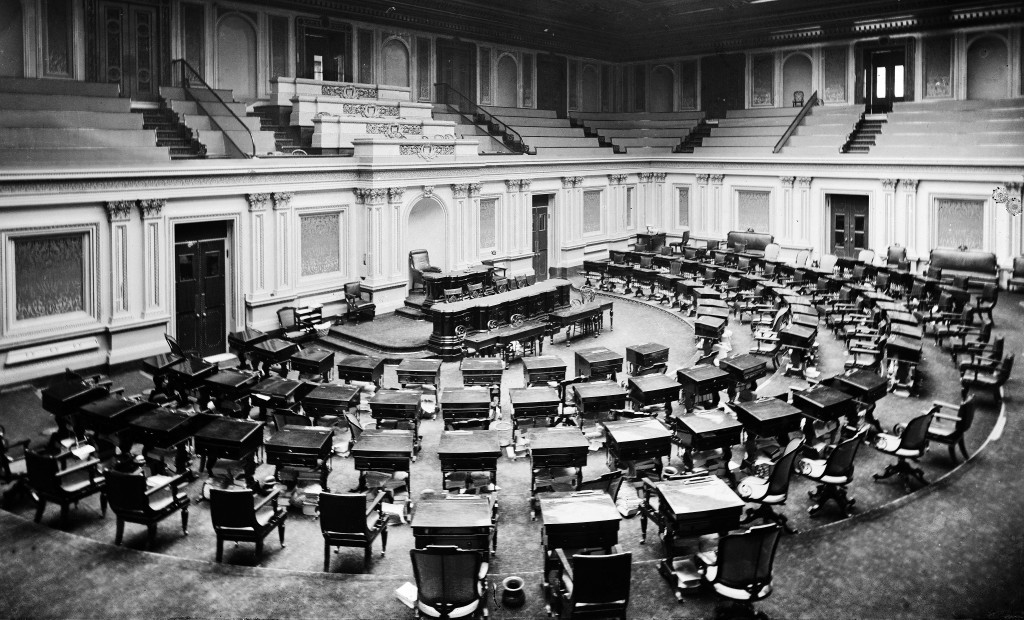AHA Today , From the National History Center
Making History Relevant to Policymaking
A Classroom Guide on Implementing the Mock Policy Briefing Program
Editor’s Note: This is the last in a three-part series of blog posts on the National History Center’s Mock Policy Briefing Program, which Jessica Roney implemented in her course on the history of Philadelphia at Temple University. Part One discussed the rationale and relevance behind incorporating the program in a history classroom, while Part Two offered reflections on the program from students in Roney’s class. The Mock Policy Briefing Program Educator’s Workshop on “Understanding History’s Relevance to Today” will be held in Philadelphia on April 6.

The National History Center’s Congressional Briefings program seeks to provide Congressional staff and members with historical perspectives on current policy issues. The Mock Policy Briefing Program provides a model to develop and host policy briefings in history classrooms. Credit: Wikimedia Commons
When I sat down to write the syllabus for The History of Philadelphia in the summer of 2015, I faced some difficult questions: Could I create a group project that involved the entire class? If I did, how would I assess each student’s contributions? How would I make sure that everyone in the 22-person class had shouldered her fair share of the work?
The animating idea for the course was to incorporate a mock policy briefing based on the National History Center’s (NHC) Congressional Briefings program—students would research the history of a modern-day policy matter important to Philadelphia, and at the end of the semester discuss their findings with policy makers. This meant that the entire class would collaborate on a single research project, translate their findings into a unified, coherent presentation, and deliver it effectively to an external audience. Fortunately, the NHC has a template, which I adapted pretty much whole. Organizationally, I divided the semester into two parts—the first based on individual work; the second working as a group.
Researching individual topics: First students chose and researched a wide range of individual topics. Many wanted to know more about the Philadelphia public school system, which is currently experiencing considerable difficulties. Others wanted to study gentrification, police-community relations, or hunger. We were privileged to have former mayoral candidate and current historical documentary filmmaker Sam Katz come speak to the class about how to ask good questions and to think about some of the issues facing the city today. To help them access a range of primary and secondary resources, I also organized a session with our history resource and special collections librarians.
Presenting individual topics: Next, the students presented their topics to the rest of the class in anticipation of a class vote. To help, I asked a graphic designer to speak to them about effective presentation and design strategies. I emphasized here that the students should think of their presentations as a “pitch” to convince their classmates to vote for that topic. To that end, initial research was important, but so was the ability effectively to convey the stakes behind and the viability of a particular topic.
The vote: After every student presented, I distributed ballots. Each student got two equal votes so that everyone didn’t just vote for their own topic. The first ballot narrowed us down to two topics and in a run-off vote between Philadelphia schools and poverty, the students chose the latter. I was surprised. Only one student had researched poverty, whereas a number had been looking at schools. However, the student who had presented on poverty gave such an effective presentation, and had outlined so clearly avenues of future research for the class, that he won over the majority.
Research clusters: Now the class committed to researching the history of poverty in Philadelphia. The students decided to divide into three groups based on chronological periods. In their small research groups the students came up with lists of questions. Each student took responsibility for a particular question or area to research and then after two weeks circulated a report to the rest of the group. They checked in frequently with one another, shared resources, and assembled a rough outline of what they had and what they still needed.
Each chronological group also put together an eight-minute presentation of their research for the rest of the class. They gave one another feedback, asked questions, and brainstormed how to make their individual segments more consistent with one another. Soon after, each group presented again, incorporating new research and the suggestions of their classmates to fill in any gaps and to increase consistency between the groups.
Tasks: The research clusters were not the students’ only assignments, however. In addition, each student joined a task-oriented committee. One group was responsible for inviting Philadelphia policy makers to our final presentation. They drew up the list, drafted the invitation, and corresponded with the invitees.
Another group was tasked with taking the work of the three research groups and making a single, consistent, and coherent PowerPoint presentation with as much graphic impact as possible. Another group was responsible for the final script. They took the outlines and research of the groups and made sure that they worked together in the final analysis and they wrote an overall introduction and conclusion.
Final presentation: We had a dress rehearsal of our final presentation in the second-to-last class, and then in the final class, we gave our presentation. One student acted as the emcee; it was her job to open and introduce the entire presentation and at the end to offer the conclusion. The body of the presentation was divided into three chronological periods reflecting the research groups. One or two students from each group gave their section of the presentation. In all, six students out of a class of 22 actually spoke in the presentation. The rest, all dressed in professional attire, sat in the front of the class, ready to take questions at the end of the presentation. We got some probing questions, and the students shared the responsibility for answering them. No one was an expert on the entire presentation, but everyone was an expert on some individual part of it. As the conversation went on and deepened, students also began contributing their personal experiences and reflections as residents of Philadelphia.
We learned a great deal piloting the policy briefing model. The students wished that they’d had more time to work on the final research project. They felt that they put too much time into their individual proposals, and that as a consequence the final presentation had been rushed. Some suggested selecting a single topic much earlier in the semester, or even assigning one from the start. (You can read more on the students’ feedback here.) The audience of policy makers was also less well-attended that I had hoped.
In closing, I offer a new strategy, one that might address these issues. Next time I might approach staff members at a local nonprofit before teaching the class and ask them to brainstorm what historical question might aid them in their work. Then the class would partner with that particular organization from the beginning to focus on the question they indicated. Philadelphia, like any city, has a wealth of current policy questions that can benefit from a longer historical perspective. Empowering students and helping guide them to the tools to do the work of filling in that background is a service, not only to them but to the larger community of which they are a part.
Jessica Choppin Roney is assistant professor of history at Temple University in Philadelphia. She is the author of Governed by a Spirit of Opposition: The Origins of American Political Practice in Colonial Philadelphia (John Hopkins Univ. Press, 2014).
This post first appeared on AHA Today.
Tags: AHA Today From the National History Center Teaching Resources and Strategies
Comment
Please read our commenting and letters policy before submitting.







